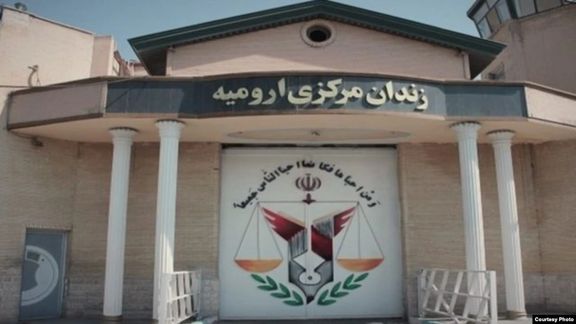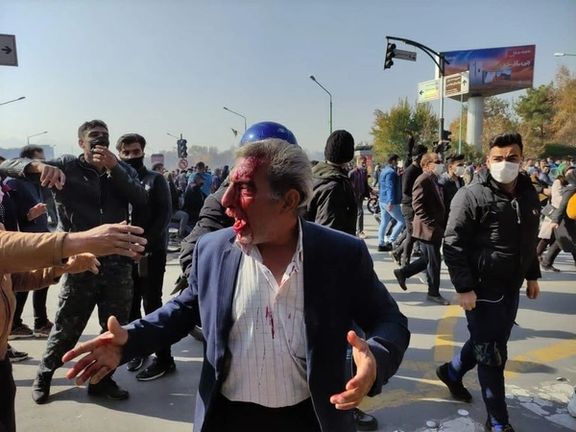Female Prisoners Beaten By Guards In Iran After Protest

Female prisoners were beaten by guards in Iran’s Urmia after they protested and set fire to blankets following restrictions on their movements.

Female prisoners were beaten by guards in Iran’s Urmia after they protested and set fire to blankets following restrictions on their movements.
A new prison warden imposed restrictions recently on the pretext that female prisoners were not attending Quran classes. He limited the time inmates could spent outdoors and their movements inside the prison.
Hengaw human rights monitoring group reported that after guards assaulted the prisoners, they were forced to sign a pledge on Friday “not to participate in any protest.”
There are many Kurd inmates in Urmia’s prison. The northeastern city has a mixed Kurdish and Azari population, and its prison also houses Kurdish political activists.
A report by another Iranian human rights group recently said Iran’s intelligence services maintain “secret prisons” in the region and torture and rape political detainees.
Assaulting prisoers, torture and rape have been reported before in Iran’s prisons.

Democratic and Republican US senators announced legislation on Thursday that would impose sanctions on Iran for “transnational terror campaign.”
This year there was an alleged plot by Iranian intelligence agents to kidnap Iranian-born US activist Masih Alinejad.
Democrat Ben Cardin and Republican Pat Toomey said their legislation would seek to hold Iran accountable for the plot and prevent any further attempted kidnappings on US soil by imposing mandatory sanctions on those involved and authorizing secondary sanctions on banks doing business with them.
US prosecutors charged four Iranian operatives in July with plotting to kidnap Alinejad, a journalist and activist who was critical of Tehran. Iran has called the allegation "baseless."
"If you dare to attempt to come to our nation and kidnap an American citizen, there will be dire consequences," Cardin told a news conference with Toomey and Alinejad, who said she came out of hiding for the event at the US Capitol.
The bill's path to becoming law was not immediately clear, but Cardin and Toomey said they would do everything possible to see it was passed and sent to the White House for President Joe Biden to sign into law.
"I am cautiously optimistic," Toomey said.
Report by Reuters

Masih Alinejad, an Iranian activist says that she would join two US Senators introducing a law named after her, aimed at Iran’s “transnational terror campaign.”
No details of the legislation proposed by Democrat Ben Cardin and Republican Pat Toomey have been published. It may propose additional sanctions against Iran just as diplomats in Vienna are working to revive the 2015 agreement limiting Iran’s nuclear program.
Alinejad, a best-selling author based in New York, was reportedly the target of an Iranian plot to kidnap her and take her to Iran via speedboat to Venezuela. A vocal supporter of strong US measures against the Islamic Republic, Alinejad has accused the Biden administration of ignoring human rights violations by Iran for the sake of reviving the 2015 nuclear deal, the JCPOA (Joint Comprehensive Plan of Action) nuclear program.
Alinejad was contacted by US Secretary of StateAntony Blinken after an interview with CNN in July in which she requested a meeting with President Joe Biden. In 2019 Alinejad had a well-publicized meeting with President Donald Trump’s Secretary of State Mike Pompeo.
Blinken said that the US would “support the indispensable work of independent journalists around the world,” and would not “tolerate efforts to intimidate them to silence their voices.”
Alinejad tweeted a readout of the call saying Blinken had found the idea that Tehran would abduct her from the US “particularly egregious.” She added Blinken had assured her the Biden administration would hold Iran accountable for the alleged plot.
The US Justice Department announced July 13 that four Iranian nationals were indicted on charges of conspiracies related to kidnapping, sanctions violations, bank and wire fraud, and money laundering, and a co-conspirator was facing additional structuring charges. One of the Iranians awaits trial in the US.
Although the Justice Department statement stressed that an indictment did not establish guilt and specifically avoided names, Alinejad announced she had been targeted for abduction along with other journalists from Canada and the United Kingdom and the Federal Bureau of Investigation (FBI) had protected and monitored her home for months.
Dozens of Iranian journalists in other countries, including those working for BBC Persian TV and London-based Iran International TV, repeatedly complain about their own and their family members' harassment in Iran, and say they had been warnedby authorities about possible actions.
Iran executed in December 2020 Rouhollah Zam, editor of a social-media channel, after he was kidnapped in Iraq and convicted on security charges and televised confessions, without due process of law.

A former Iranian prison guard on trial in Sweden for his role in killings of thousands of prisoners in 1988, denied any knowledge of a prisoner mass grave.
Hamid Noury (Nouri) was arrested in November 2019 while visiting Sweden and charged with war crimes for his role in the execution of up to 5,000 political prisoners in Iran serving jail time. Sweden used the principal of universal jurisdiction to arrest and prosecute Noury, because the alleged crimes amounted to war crimes.
The cemetery called Khavaran is in southeast Tehran and an unmarked mass graveyard where at least dozens of executed prisoners are buried. Families of victims visit the cemetery regularly and lay flowers, although no one is certain about the exact identity of those buried in Khavaran.
Noury during the latest court session claimed he first heard about the graveyard when he was arrested in Sweden. He has also denied any role in the mass killings, although tacitly accepting that prisoners were executed. Dozens of witnesses, including prisoners who witnessed the summary trials in the summer of 1988, have testified in court against Noury.

Iran's state television Tuesday aired "confessions" of a young woman and man admitting to torching the tents of farmers protesting in Esfahan to provoke a riot.
The city protests, centered in the dried-up Zayandeh Roud riverbed, ended in security forces confronting the protesters with tear gas and shotguns on Thursday and Friday with at least 67 arrests and scores of injuries. "The confessions of these detainees show that the enemy cares nothing about the rightful demands of the farmers and the people of Esfahan," the program noted.
The two detainees − whose faces were obscured and voices distorted, purportedly to protect their identities − said they had poured fuel around the farmers’ tents in the early hours of Thursday.
"Burn the tents," the woman claimed she called out to her male companion, named as Mehdi. She said security forces were subsequently very polite "and pleaded with people to go home.”
The young man in the video said he had found empty tear-gas canisters that he used with red paint to create images of bloodshed for photos and films, presumably to circulate on social media.
Ophthalmologists in the past few days have reported tens of cases of eye injuries caused by shotgun pellets. A medical official told Iranian state television Saturday that 40 people had been treated for eye injuries sustained during the protests, with 19 hospitalized.
An injured eye has become a social-media symbol for the suppression of Friday's protests, with many activists posting images of bloody eyes or people holding bandage to an eye.

Iran has a long history of staged confessions of activists and those allegedly accused of ‘terrorist’ operations, including instances of people yet to be charged.
Tuesday’s program claimed that the two confessing to their role in Esfahan and others had played “a direct role in instigating the farmers to continue their protest." Other outlets, including Tasnim news agency, have circulated excerpts from the program including on Twitter alongside the caption "Confessions of a rioter woman in recent incidents in Esfahan.”
Authorities and hardliner media have accused some Esfahan protestors of being rioters and "agents of the enemies" who tried to highjack the farmers' legitimate protests over water shortages that have wracked the region in recent years. Kayhan newspaper called the protesters "America's foot soldiers" who perverted the water protests to "sow unrest and reap sanctions" ahead of Iran’s nuclear talks with world powers in Vienna, which resumed Monday. The chief of Esfahan province's justice department said Tuesday that those responsible would face speedy prosecution.

A former revolutionary says Supreme Leader Ali Khamenei is personally responsible for the "the atrocities committed" against peaceful protesters in Esfahan.
In a statement published on the ‘Kalemeh’ Telegram social-media channel Sunday, Abolfazl Ghadiani wrote that “all of the suppressive bodies…and their commanders are responsible for the [attack on] the peaceful, civil and non-violent protest of the people of Esfahan, but the central figure responsible for this aggression and the atrocities committed is Iran's dictator Ali Khamenei who must be held accountable.”
Ghadiani who was a political prisoner both during the monarchy and the Islamic Republic, blames the government for mismanaging water resources and accused security forces of setting fire to the tents of farmers protesting against a lack of water in the dry riverbed of Zayandeh Roud Thursday.
Ghadiani, who was imprisoned on charges of "propaganda against the regime" and "insulting the Supreme Leader" after the disputed 2009 presidential election, said security forces had “wounded a large number of protestors.”
Hasan Karami, a police commander, said Sunday that 2-3,000 "opportunists" had joined Friday's protests and that 67 had been arrested. The United States-based Center for Human Rights in Iran said Monday that at least 214 including 13 children had been arrested in total during the “recent protests.”
Social media users have posted photos of people with shotgun pellet injuries to their backs, legs and faces, including an old man with multiple pellet injuries to his back and a young boy who they claim lost both his eyes.
Iran International TV has obtained radiology images of a protester with tens of pellets embedded in his head, neck, and upper torso.

A medical official told Iranian state television Saturday that 40 people had been treated for eye injuries sustained during the protests, with 19 hospitalized. He did not specify how the injuries were sustained.
Chief Justice Gholam-Hossein Mohseni-Ejei said in a meeting of the judiciary's supreme council Monday that people had a right to look for solutions to their problems but warned them to be wary of the "enemies’ moves" and refuse to allow them to "infiltrate their ranks.”
He suggested that "ignorant people, ill-wishers and agents of foreign powers" had taken advantage of the protests seeking to "disturb people's peace and security."
Brigadier-General Abolfazl Shekarchi, spokesman of the armed forces, said that the “enemy wrongly thinks that the citizens of the Islamic Republic have turned their backs on it, do not want the authorities, and seek regime change."
Kayhan newspaper reported Sunday that "America's foot soldiers" had perverted the water protests to "sow unrest and reap sanctions" ahead of Vienna nuclear talks, which resumed Monday.